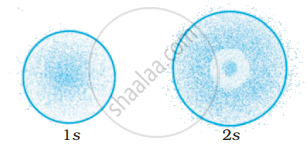Advertisements
Advertisements
प्रश्न
Write orbital notations for the electron in orbitals with the following quantum numbers.
n = 2, l = 1
उत्तर
2p
APPEARS IN
संबंधित प्रश्न
Using s, p, d notations, describe the orbital with the following quantum numbers n = 1, l = 0.
Using s, p, d notations, describe the orbital with the following quantum numbers n = 4; l =3.
State and explain Pauli’s exclusion principle.
Write orbital notations for the electron in orbitals with the following quantum numbers.
n = 3, l = 2
Write condensed orbital notation of electronic configuration of the following element:
Carbon (Z = 6)
Write condensed orbital notation of electronic configuration of the following element:
Oxygen (Z = 8)
Indicate the number of unpaired electron in:
Cr (Z = 24)
How many electrons in 19K have n = 3, l = 1?
How many electrons can fit in the orbital for which n = 4 and l = 2?
The probability density plots of 1s and 2s orbitals are given in Figure:

The density of dots in a region represents the probability density of finding electrons in the region.
On the basis of above diagram which of the following statements is incorrect?
Which of the following properties of atom could be explained correctly by Thomson Model of atom?
The pair of ions having same electronic configuration is ______.
Out of the following pairs of electrons, identify the pairs of electrons present in degenerate orbitals:
| (i) | (a) `n = 3, l = 2, m_l = -2, m_s = - 1/2` |
| (b) `n = 3, l = 2, m_l = -1, m_s = - 1/2` | |
| (ii) | (a) `n = 3, l = 1, m_l = 1, m_s = + 1/2` |
| (b) `n = 3, l = 2, m_l = 1, m_s = + 1/2` | |
| (iii) | (a) `n = 4, l = 1, m_l = 1, m_s = + 1/2` |
| (b) `n = 3, l = 2, m_l = 1, m_s = + 1/2` | |
| (iv) | (a) `n = 3, l = 2, m_l = +2, m_s = - 1/2` |
| (b) `n = 3, l = 2, m_l = +2, m_s = + 1/2` |
Which of the following sets of quantum numbers are correct?
| `n` | `l` | `m_l` | |
| (i) | 1 | 1 | +2 |
| (ii) | 2 | 1 | +1 |
| (iii) | 3 | 2 | –2 |
| (iv) | 3 | 4 | –2 |
Nickel atom can lose two electrons to form \[\ce{Ni^{2+}}\] ion. The atomic number of nickel is 28. From which orbital will nickel lose two electrons.
Which of the following orbitals are degenerate?
3dxy, 4dxy 3dz2, 3dyz, 4dyz, 4dz2
The arrangement of orbitals on the basis of energy is based upon their (n + l) value. Lower the value of (n + l), lower is the energy. For orbitals having same values of (n + l), the orbital with lower value of n will have lower energy.
Based upon the above information, arrange the following orbitals in the increasing order of energy.
5p, 4d, 5d, 4f, 6s
The arrangement of orbitals on the basis of energy is based upon their (n + l) value. Lower the value of (n + l), lower is the energy. For orbitals having same values of (n + l), the orbital with lower value of n will have lower energy.
Based upon the above information, solve the questions given below:
Which of the following orbitals has the lowest energy?
4d, 4f, 5s, 5p
Match the following species with their corresponding ground state electronic configuration.
| Atom / Ion | Electronic configuration |
| (i) \[\ce{Cu}\] | (a) 1s2 2s2 2p6 3s2 3p6 3d10 |
| (ii) \[\ce{Cu^{2+}}\] | (b) 1s2 2s2 2p6 3s2 3p6 3d10 4s2 |
| (iii) \[\ce{Zn^{2+}}\] | (c) 1s2 2s2 2p6 3s2 3p6 3d10 4s1 |
| (iv) \[\ce{Cr^{3+}}\] | (d) 1s2 2s2 2p6 3s2 3p6 3d9 |
| (e) 1s2 2s2 2p6 3s2 3p6 3d3 |
Match the quantum numbers with the information provided by these.
| Quantum number | Information provided |
| (i) Principal quantum number | (a) orientation of the orbital |
| (ii) Azimuthal quantum number | (b) energy and size of orbital |
| (iii) Magnetic quantum number | (c) spin of electron |
| (iv) Spin quantum number | (d) shape of the orbital |
Which of the following is the correct plot for the probability density ψ2 (r) as a function of distance 'r' of the electron from the nucleus for 2s orbitals?
Which of the following is not the permissible arrangement of electrons in an atom?
Which of the following element do not follow Aufbau principle?
